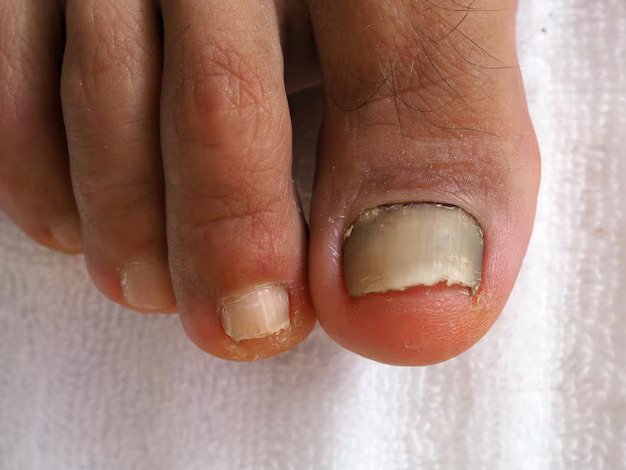Iodine For Toenail Fungus
Toenail fungus, medically known as onychomycosis, is more than just a cosmetic issue—it’s a persistent and often stubborn condition that affects millions of people worldwide.
Characterized by yellowing, thickening, crumbling, and sometimes painful toenails, this fungal infection can linger for months or even years if not properly treated.
While pharmaceutical treatments are available, they often come with side effects, high costs, and limited effectiveness. This has driven many individuals to explore natural and affordable alternatives. Among the growing list of home remedies, one surprising yet promising option is iodine.
In this article, we will explore in detail how iodine works against toenail fungus, its benefits, the science behind it, how to use it correctly, and potential precautions to take. By the end, you’ll have a comprehensive understanding of whether iodine could be the solution you’ve been seeking for stubborn toenail fungus.

What is Toenail Fungus?
Toenail fungus is caused by various types of fungi, including dermatophytes, yeasts, and non-dermatophyte molds.
These organisms thrive in warm, moist environments—think sweaty socks, gym shoes, or shared showers. Once they find a home under your nail, they feed on keratin, the protein in your nails, and slowly take over.
Common Symptoms:
- Discoloration (yellow, brown, or white spots)
- Thickening of the nail
- Brittleness or crumbling at the edges
- Separation from the nail bed
- Odor or pain (in severe cases)
Toenail fungus is notoriously difficult to treat due to the protective barrier of the nail plate, which prevents topical treatments from penetrating deeply enough to kill the fungi at the root.
Iodine: A Brief Overview
Iodine is a trace mineral that’s essential for human health. It plays a critical role in thyroid hormone production, but more importantly in the context of toenail fungus, it’s also a powerful antiseptic and antimicrobial agent.
Iodine has been used for decades in medical settings for wound disinfection and sterilization. It kills bacteria, viruses, and fungi by disrupting their protein and nucleic acid structure.
Forms of Iodine Used Topically:
- Tincture of Iodine – Alcohol-based solution, usually 2% iodine and 2.4% sodium iodide in alcohol.
- Povidone-Iodine (Betadine) – A complex of iodine with a polymer (povidone), which allows slow release and less skin irritation.
Both are available over-the-counter and can be found in pharmacies and online stores.
Can Iodine Cure Toenail Fungus?
The short answer: Iodine may significantly help treat toenail fungus, especially in its early stages. It’s not necessarily a miracle cure, but its antifungal properties make it a compelling option.
Mechanism of Action:
Iodine works by:
- Penetrating the nail tissue to reach the fungal colonies.
- Disrupting the cellular structure of fungi, leading to their death.
- Reducing bacterial co-infections, which can occur secondary to fungal infections.
Clinical Evidence:
Several studies and anecdotal reports suggest iodine’s effectiveness:
- A study published in the Journal of the American Academy of Dermatology found that povidone-iodine combined with DMSO (dimethyl sulfoxide) significantly improved symptoms in patients with fungal nail infections.
- Laboratory tests have confirmed iodine’s fungicidal effects against Trichophyton rubrum, one of the most common causes of toenail fungus.
While more large-scale clinical trials are needed, existing evidence supports iodine as a viable natural antifungal agent.
Benefits of Using Iodine for Toenail Fungus
1. Affordable and Accessible
Unlike expensive prescription antifungal medications, iodine is inexpensive and widely available. A small bottle can last for weeks or even months.
2. Broad-Spectrum Antimicrobial
Iodine doesn’t just fight fungi; it also combats bacteria and viruses. This is particularly beneficial if the toenail fungus has caused secondary infections or inflammation.
3. Minimal Side Effects
Topical iodine is generally safe when used correctly. Unlike oral antifungal medications, it does not carry a risk of liver damage or severe drug interactions.
4. Non-Resistance
Unlike antibiotics and some antifungal drugs, there’s no significant evidence that fungi develop resistance to iodine. This makes it a reliable long-term option.
How to Use Iodine for Toenail Fungus
Using iodine effectively requires consistency and correct application technique. Here’s a step-by-step guide:
Step 1: Clean the Affected Area
- Wash your feet thoroughly with soap and warm water.
- Dry completely, paying special attention to the space between your toes and under the nail.
Step 2: File Down the Nail
- Use a sterile nail file to thin the affected toenail.
- This helps the iodine penetrate deeper.
- Dispose of the file or disinfect it to prevent reinfection.
Step 3: Apply the Iodine
- Use a cotton swab or dropper to apply a small amount of iodine solution directly to the affected toenail.
- Let it absorb and dry naturally.
Frequency:
- Apply once or twice daily, preferably in the morning and before bed.
- Treatment duration can range from several weeks to months, depending on severity.
Optional Enhancer:
- Combine with DMSO for deeper penetration. DMSO acts as a carrier and can transport iodine through the nail plate and into the nail bed, where the fungus resides.
Caution: Only use pharmaceutical-grade DMSO, and consult a healthcare provider before combining with other substances.

Potential Side Effects and Precautions
While iodine is generally safe, some users may experience:
- Skin irritation or dryness
- Temporary nail discoloration (darkening or yellowing due to iodine staining)
- Allergic reactions (rare, but possible)
Who Should Avoid Iodine?
- Individuals with iodine allergies
- People with thyroid conditions, particularly hyperthyroidism
- Pregnant or breastfeeding women (consult your doctor first)
- Those on radioactive iodine treatments
Always do a patch test before applying to a large area. If you experience itching, redness, or swelling, discontinue use and consult a healthcare professional.
Tips to Maximize Effectiveness
- Be Consistent – Like most fungal treatments, iodine requires persistence. Don’t skip applications.
- Keep Nails Trimmed and Clean – Prevent buildup and improve iodine penetration.
- Wear Breathable Footwear – Let your feet breathe and reduce moisture.
- Change Socks Daily – Keep your feet dry and clean to avoid reinfection.
- Disinfect Shoes – Fungal spores can linger in shoes and socks. Use antifungal sprays or UV sanitizers regularly.
Iodine vs. Other Natural Remedies
| Remedy | Antifungal Strength | Penetration Ability | Side Effects |
| Iodine | High | Moderate to High | Low |
| Tea Tree Oil | Moderate | Moderate | Moderate |
| Vinegar | Low to Moderate | Low | Low |
| Coconut Oil | Mild | Low | Minimal |
| Vicks VapoRub | Moderate | Moderate | Low |
| Hydrogen Peroxide | Moderate | Moderate | Moderate |
Among these, iodine stands out for its potency, broad antimicrobial action, and cost-effectiveness.
When to See a Doctor
While iodine can be effective, it’s not a guaranteed cure for everyone. Consider seeking professional help if:
- The fungus spreads to other nails or skin.
- There is severe pain, swelling, or pus (signs of bacterial infection).
- You have a compromised immune system or diabetes.
- No improvement is seen after 3 months of regular treatment.
A podiatrist or dermatologist can offer options such as oral antifungals, laser treatments, or minor surgical removal in extreme cases.
Final Thoughts
Toenail fungus can be an embarrassing and persistent problem, but it doesn’t have to control your life. Iodine, with its powerful antifungal properties, low cost, and ease of use, represents a promising natural alternative to prescription medications.
While results can vary, many people have found success with daily iodine applications—especially when combined with good foot hygiene and lifestyle changes. As with any treatment, consistency and patience are key.
If you’re seeking a science-backed, low-risk solution, iodine for toenail fungus might just be the remedy your feet have been waiting for.
Frequently Asked Questions (FAQs)
1. How long does it take for iodine to work on toenail fungus?
Results vary, but noticeable improvement often begins within 4–6 weeks. Full treatment may take 3–6 months or longer, depending on the severity.
2. Can iodine cure toenail fungus completely?
While it can eliminate the fungus in many cases, recurring infections are common if preventative measures aren’t taken. Combine treatment with good hygiene practices.
3. Will iodine stain my toenail?
Yes, it can cause temporary yellow or brown discoloration. This is harmless and fades over time.
4. Is it safe to use iodine every day?
Yes, when applied topically in small amounts, daily use is generally safe. However, avoid excessive use and monitor for signs of irritation.
5. Can I use iodine and another antifungal cream together?
It’s possible but may increase the risk of irritation. Consult a healthcare professional before combining treatments.
References
- https://doi.org/10.1007/s11046-015-9966-2
- https://www.jaad.org/article/S0190-9622(18)30306-5/fulltext
- https://link.springer.com/article/10.1007/s13281-020-00384-6
- https://www.mayoclinic.org/diseases-conditions/nail-fungus/symptoms-causes/syc-20353294
- https://medlineplus.gov/druginfo/meds/a682158.html